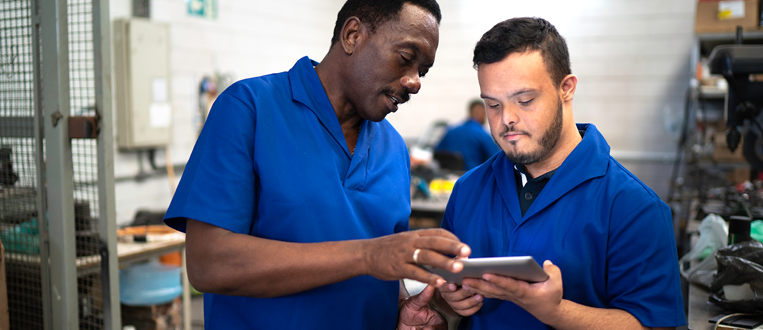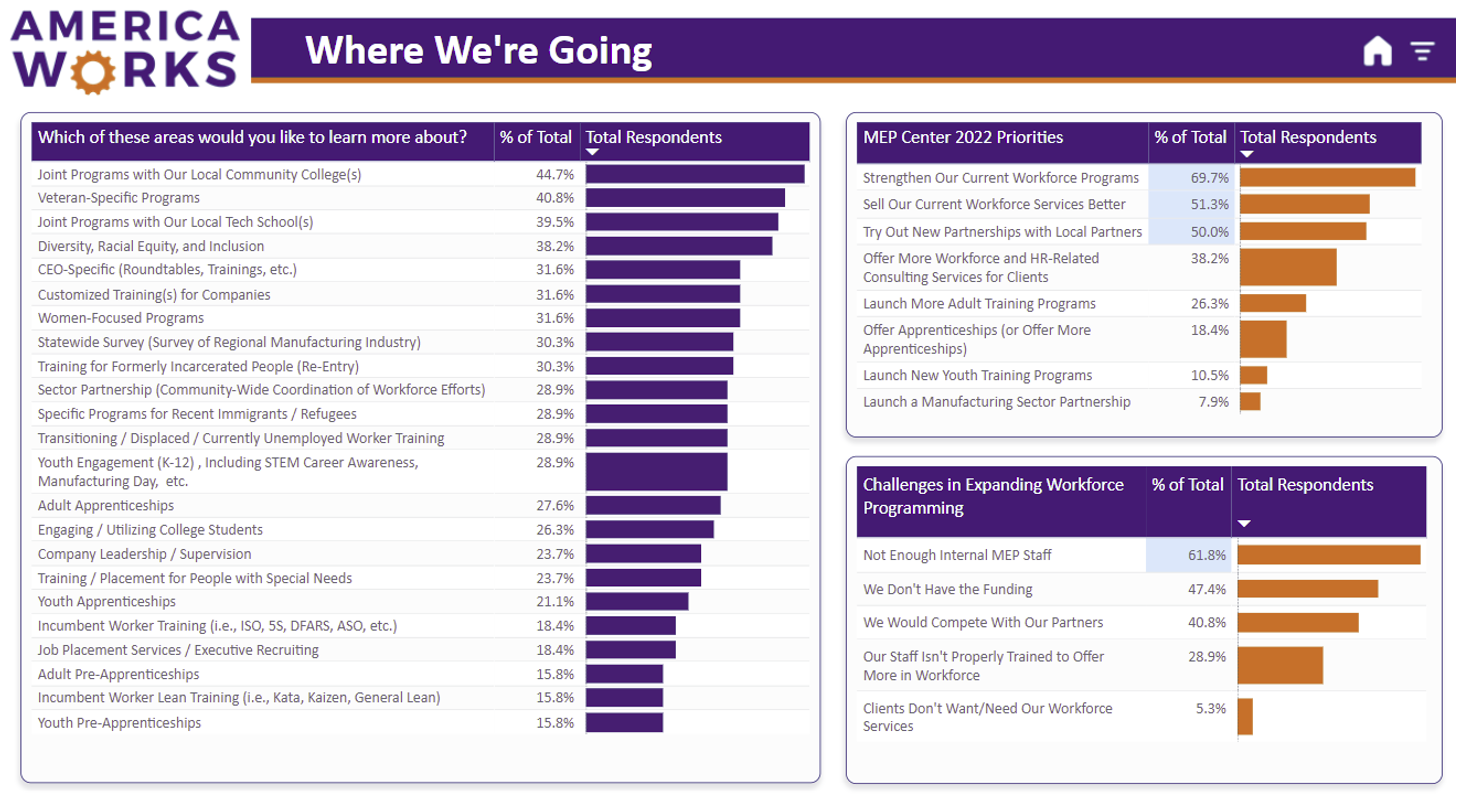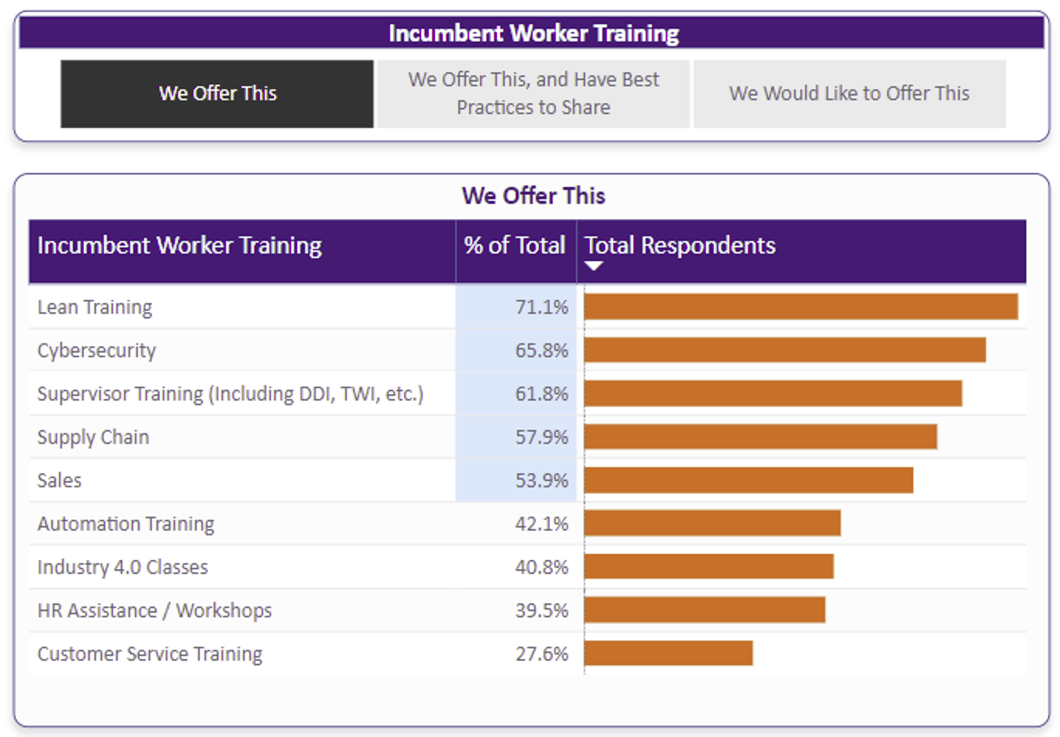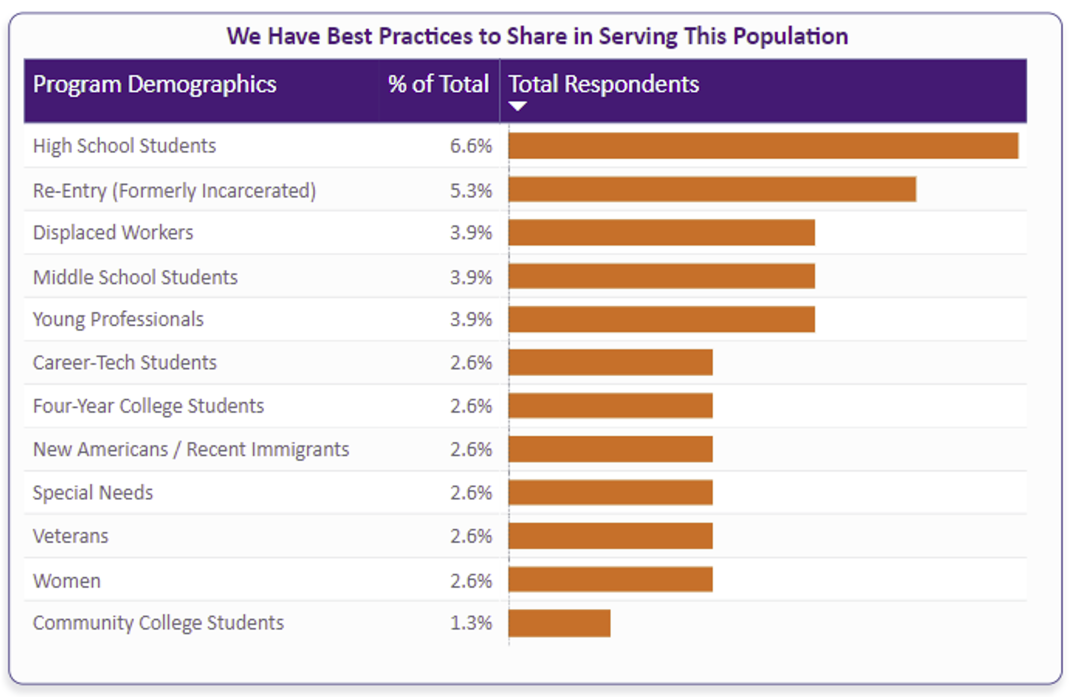Manufacturing Innovation Blog
Powered by the Manufacturing Extension Partnership

This blog is part of a monthly series brought to you by the America Works initiative. As a part of the MEP National Network’s goal of supporting the growth of small and medium-sized manufacturing companies, this series focuses on innovative approaches and uncovering the latest trends in manufacturing workforce development.
The 2022 MEP Workforce Survey conducted by America Works asked for just one response from each MEP Center and their subrecipients. I’m excited to tell you that we had 100% participation, receiving 76 responses from 51 Centers nationally. MEP Centers represent a diverse group, with 58% incorporated as independent nonprofits, 29% working as part of a university, and 12% working either as part of a state or community college. Like our clients, most MEP Centers have a limited workforce team. While the average was 3.2 full-time employees (FTEs), the median response was 1.8; perhaps more simply, 47% of respondents had one FTE or less.
Let’s back up. How do MEP Centers help America’s manufacturers?
MEP Centers serve all 50 states and Puerto Rico, supporting their regions’ small and medium-sized manufacturers (typically up to 500 employees) with many of their growth needs including new product development, supply chain, improved operations, human resources and more. I like to say that MEP Centers help manufacturers grow locally while competing globally.
OK, so what is the MEP Workforce Survey?
As we discussed way back when America Works kicked off in March 2021, improving the collaboration, cooperation and communication between MEP Centers’ workforce efforts requires two essential ingredients: data on what they’re currently doing in workforce, and information on what they want to be doing in workforce in the future.
Essentially, the survey has two goals. First, figure out where the puck is currently, understand where it’s going, and then stay ahead of the trends with programming that supports MEP Centers on their individual workforce journeys. Second, empower the MEP Centers to connect with each other directly so they can share their best practices and lessons learned, making the Network more efficient. The 2021 Survey offered a starting baseline and gave us a good starting point; the 2022 version is more interactive, more in-depth and has a better interface to facilitate more MEP Center staff using it to accomplish those two goals. For example, users can filter by the type of MEP Center or even zero in on the responses of one or more specific Centers.
That’s exciting. Why don’t we start by looking at the priorities of the Centers in 2022?
That’s as good a place as any! Because the survey was conducted in January, we wanted to capture what Centers wanted to accomplish this year. Three clear priorities emerged: 70% of respondents want to strengthen their current programs, 51% want to sell their current workforce services better, and 50% want to try out new partnerships with local partners.

Now, let’s focus on workforce. What are the main services being offered nationally?
MEP Centers are leading their communities and promoting workplace development in a host of different areas. Roughly two-thirds of Centers are offering Manufacturing Day programming and leadership development programs. More than half are offering organizational assessments and consulting on employee recruitment and retention. In terms of incumbent worker trainings, 93% of Centers offer some form of technical training, and 78% offer some sort of supervisory training. Below, you can see their diverse range of offerings:

To strengthen these services, many MEP Centers are offering certifications as well. These range from lean (72%) and quality (65%) to Food Safety Modernization Act (FSMA, 29%) and Manufacturing Skill Standards Council (MSSC, 9%) certifications.
That’s interesting about services, but now let’s talk about people. What populations are MEP Centers serving?
Honestly, this is where I was surprised because 61% of Centers said they have programs specifically geared toward attracting and retaining young professionals, and another 50% said they have programs specifically for women. In the past, these groups haven’t often been specifically supported by MEP Centers, so this is a new development within the Network. Rounding out the top five responses, community college students, veterans and career-tech students were also served by more than 50% of the Network.
Let’s look at the future. What services and programs would MEP Centers like to offer?
Not surprisingly, MEP Centers are rapidly moving to stay current with the times and with their clients. MEP Centers are on the front lines of diversity, equity and inclusion, with more Centers offering consulting in this area every day. Offering youth apprenticeships and pre-apprenticeships are a close second, with peer roundtables, expanded HR consulting offerings, and sector partnerships rounding out the top responses. In terms of trainings, 41% of Centers said they would like to offer Industry 4.0 classes, with supply chain and automation training each coming in at around 28%.
Centers would also like to reach out to new populations that that might be interested in manufacturing careers, with recent immigrants being the most popular group (36%) and returning citizens a close second (32%).
Let’s talk money. What is the funding landscape for workforce services?
Workforce services are not only good for our clients and for the general public, but they also generate valuable revenue for Centers. Of the respondents, 92% are generating client fees from these services, with just 4% of respondents saying these services lose money for their Center. Current funders include state grants (78%) and the federal government (62%). One area where the Network could improve is in attracting philanthropic funding (22%).
You mentioned this is about more than just data.
That’s right, this is also about connection. As you can see in these graphics, almost every question offers the chance to respond, “We offer this, and have best practices to share.” With a simple click, a staff member can pull up the contact information of any colleague who indicated they would like to share their knowledge or skills nationally.

OK, that’s all interesting, but what’s ONE statistic that really stuck out for you, Matt?
Good question! When we asked, “What’s holding your workforce efforts back?”, only 5% said that their clients didn’t want workforce services. That means that 95% of Centers are seeing a steady or increased demand for workforce services, whether that’s incumbent worker trainings to increase the skills of current workers, or pipeline programs to attract more workers. That tells me that we need to double-down on expanding workforce services locally, continue funding workforce innovation, and strengthen the connective tissue nationally to better serve the American manufacturing industry.
Clearly, there’s more to say, but let’s wrap this up. What other areas does the survey measure?
While too involved for this blog post, we also wanted to understand how Centers are working in the context of their state or region. So, we asked specifically: Who are your partners? How knowledgeable are you about your local workforce ecosystem? What is the relationship with your state as it relates to funding? What are the challenges you face as you expand your workforce efforts? The answers to these questions can be found in the database along with the other data I’ve already discussed.
I’m ready to dive in on my own. How can I get access to the MEP Workforce Survey data?
Understandably, the MEP Workforce Database is created by MEP Centers, specifically for MEP Centers. That said, if you’d like to access the data, simply mfieldman [at] manufacturingsuccess.org (request access )and we’ll consider your request.
As I mentioned last year, we haven’t created an internet searchable database of workforce programs just yet, but with every answer generated, every new connection, and every new program supported, we’re getting better every day.


